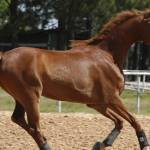Chestnut: Not Just a Coat Color

Chestnuts—those patches of rough tissue on the inside surfaces of the front legs just above the knees—are structures that remind us of the horse’s origin as a creature with more than one toe on each foot. Horses also have chestnuts on the insides of the hind legs; these are found just below the hocks. Often explained as toenail remnants from previous eons, chestnuts are actually vestiges of foot pads, the tough-fibered cushions that animals walk on. Think of cat or dog feet, and visualize the hairless toe pads found on the bottoms of the feet. These are foot pads.
At this point, we need a quick review of general anatomic terms that apply to many animals, although the structure of a horse’s leg is actually quite different from this simplified explanation. “Digital” refers to fingers or toes; “carpal/tarsal” refers to the area of the wrist/ankle in the front and rear limbs, respectively; and “metacarpal/metatarsal” refers to the area of the hand/foot in the front and rear limbs, respectively. Animals like bears that walk on the entire foot with the heel touching the ground have digital, metacarpal/metatarsal, and carpal/tarsal pads on each foot, while animals that walk more on their toes without touching the heel down (cats and dogs) have digital and metacarpal/metatarsal pads, with small or absent carpal/tarsal pads.
In today’s horses, vestigial carpal and tarsal pads are seen as chestnuts, while rudimentary metacarpal and metatarsal pads are seen in the front and hind feet, respectively, as the ergots. These small knobs of tough tissue protrude from each lower leg at the back of the pastern, where they are obscured by the hairs of the fetlock but can easily be felt. The only functional foot pad seen in the modern horse is the frog, a structure found in the rear section of each hoof and extending into the bulbs of the heels. Sweat glands in the frog produce secretions that may have functioned as trail or territorial markers in prehistoric times. Canids (dogs, wolves, foxes) and pigs share this trait.
Like human fingerprints, the basic outlines of the chestnuts are unique for each horse and are recognized by the Federation Equestre Internationale (FEI), the governing body of international equine competition, and other organizations as identifying marks. The FEI horse identification manual states, “The shape of a chestnut should be drawn in outline and related to the vertical.”
Chestnuts grow out slowly and can be peeled or trimmed back if they become excessively long. Chestnuts that are very hard and dry can be softened by applying petroleum jelly or baby oil for several days. There is living tissue at the base of each chestnut, and the area will bleed if too much of the dry layer is pulled off. Don’t try to twist the chestnuts off, as this will pull the surrounding skin and cause pain. Occasionally, horses that are very ill can actually shed their chestnuts.
Most domestic breeds as well as Przewalski’s horses have chestnuts on all four legs, though there are a few breeds that lack chestnuts on the hind legs. African wild asses and zebras also lack hind chestnuts.
One last fact: chestnuts are sometimes known as “night eyes.” The name may be based on an ancient but erroneous belief that the structures had visual abilities to help horses see their way around at night.








